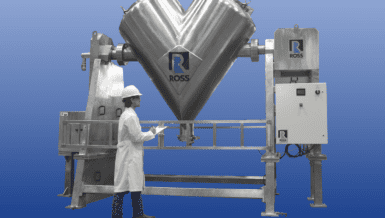Whether utilized in the food, pharmaceutical, chemical, or plastic industries, this innovation can effectively manage finite amounts of ingredients for production processes that require a course or fine flow at a uniform mass flow rate.
With applications that deal with exact amounts (even reaching plus or minus half a gram of material) an AZODOS® introduces a consistent and constant stream of ingredients into the conveying process. In this post, we’ll highlight some key factors of this customer-driven dosing device and explain how the AZODOS® can improve your manufacturing process.
The AZODOS® models offer both volumetric and gravimetric feeding
There are three different AZODOS® model types (DV, DW, and DDW). There are also five different model sizes of the AZODOS® (P30, P50, P70, P100, and P140). The AZODOS® DV model is the volumetric dosing version, which does not contain a scale. This can be used to feed a scale hopper, for example. The DW model is a dosing unit that has an integral scale and utilizes negative scaling. The feeder scaling is accomplished within system controls.

The DDW model uses the loss-in-weight principle by allowing adjustments of speed to provide a constant rate for a completely continuous process to the downstream equipment (e.g. an extruder). All the loss-in-weight feeding as well as calibrating is accomplished within the control system of the AZODOS® DDW model.
When the filling level in the DDW hopper reaches minimum weight, refilling of the product is automatically requested. While refilling occurs, the gravimetric dosing system continues to operate controlled by the screw speed and returns to loss-in-weight mode as soon as the refill process is complete.
An AZODOS® increases accuracy, reducing waste

Any manufacturing process faces challenges in eliminating major detractors of the operation’s ergonomics. Expensive ingredients are often handled manually as the ingredients themselves are of a smaller quantity. These expensive ingredients could include, for instance, separate color pigments that become part of a product-changeover. Still, there are notorious risks more closely related to manual processing than automating the handling of ingredients. These often include inherent inaccuracy, less assurance in consumer safety, and even an operator’s exposure to hazardous material.
So how do you manufacture a process to effectively handle ingredients of a smaller quality and also increase your tracking traceability with the ingredients and products you use? An AZODOS® is particularly serviceable for applications within these contexts. For certain processes knowing how much material you have used and when you have used that material is simply advantageous, but it is required by law in other cases to keep track of materials’ batches and lot numbers.
Automating your manufacturing of small or expensive ingredients will, in the event of a product recall, result in the less wasted product as you are able to track and trace the contaminated source. Significantly fewer costs associated with your operation could be a likely result as the accuracy of your tracking and tracing of specific ingredients is increased. Essentially, automating your material handling while keeping a more precise eye on the material itself is a powerful move that could make a definitive difference in an operation’s efficiency when faced with a dreaded recall.
The AZODOS® includes a control system with an open architecture
It can be incredibly frustrating in the event that your continuous feeder encounters an issue with the operation. Often in these instances, you have to call a service technician from the company that provided the machine to come in and troubleshoot a solution. With the open architecture of the control system with an AZODOS®, you have the ability to correct potential problems in-house. This takes less time to achieve, and therefore your operation can get back on track at a quicker rate.
With the proper training (which we at AZO Inc. provide) you can save downtime and resume operations should any issues arise with your continuous feeder. Essentially, with an AZODOS® you have the option to “learn to fish,” whereas some other feeders require company specialists to troubleshoot their extremely proprietary technology.
You could also liken this process to learning how to change a tire — sure, someone could accomplish this process for you (and you could stand by your car until they arrive), but the next time you have a flat (and somewhere to be), it be exponentially more efficient to already understand how to get back on the road. The open architecture of an AZODOS® control system lets you get to where you need to go with your process.















































